|
|
| Butterflies |
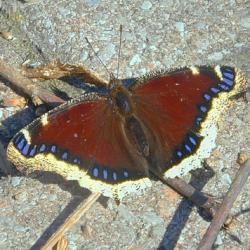 Mourning Cloak
(Nymphalis antiopa)
Description:
Wings blue-black fringed with yellow.
The yellow wing border is diagnostic, however as the butterfly
ages the border can fade to white.
Males and females have identical wing markings.
Caterpillars feed on willow, cottonwood and birch leaves.
Mourning Cloaks are long-lived as adults - up to 11 months.
Individuals seen in early spring have overwintered as adults.
They aestivate in the hottest months and reappear in the Fall.
Habitat:
Woodland, gardens.
Wingspan: 80 mm
Adults: April - October
|
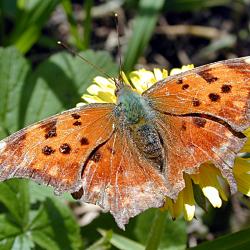 Comma
(Polygonia comma)
Description:
Burnt-orange butterfly with irregular wing outline.
The last brood in the Fall overwinters as adults, hiding under
tree bark. When they emerge in early spring, they are tattered
and their hind wings are relatively pale.
The summer form
has dark brown hind wings.
Derives its common name from a white line on the
wing underside
which looks like a scrawly punctuation mark.
Habitat:
Woodland, gardens.
Wingspan: 70 mm
Adults: May - October
|
 Compton Tortoiseshell
(Nymphalis vaualbum)
Description:
Upperside is orange-brown with darker wing tips and black spots; a
single white spot on leading edge of each wing.
Habitat:
Fields, meadows.
Wingspan: 70 mm
Adults: June - October
|
 Red Admiral
(Vanessa atalanta)
Description:
Black butterfly with red bands forming a diamond shape
and white dots towards the fore-wing margins.
The wing underside
is a complex pattern of browns and is cryptic.
Adult flight is fast and appears very haphazard.
Caterpillars live on plants in the Nettle family including stinging nettle.
Habitat:
Woodland, gardens.
Wingspan: 60 mm
Adults: April - October
|
 White Admiral
(Limenitis arthemis)
Description:
Black butterfly with white dots towards the wing margins.
Hind wing edges tipped with iridescent blue spots.
Colouring quite variable.
Individuals which have blue-purple upper wings were formerly thought to be a separate species
(called "Red-spotted Purple").
Habitat:
Fields, meadows.
Wingspan: 75 mm
Adults: June - October
|
 Orange Sulphur
(Colias eurytheme)
Description:
Bright yellow and orange butterfly.
Upper surface of wings
strikingly patterned with black in males, and grey in females.
Underwing plain yellow with spots.
Upper surface of wings darker than close relative, the Common Sulphur, but differences can be difficult to detect as these
butterflies
usually perch with closed wings.
Habitat:
Fields, meadows, roadsides.
Wingspan: 60 mm
Adults: June - October
|
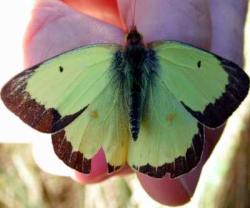 Common Sulphur
(Colias philodice)
Description:
Pale lemon butterfly.
Upper surface of wings has a solid black border in males,
whereas females have yellow spots in a grey border.
Habitat:
Fields, meadows.
Wingspan: 50 mm
Adults: June - October
|
 Cabbage White
(Pieris rapae)
Description:
White, with one (male) or two (female) rounded black spots on dorsal
forewing.
In flight looks white, but up close you will see the underwing has a pale yellow tinge.
Has become a pest in some situations since being accidentally introduced near Montreal
from Europe 150 years ago.
Habitat:
Fields, meadows, gardens.
Wingspan: 50 mm
Adults: May - October
|
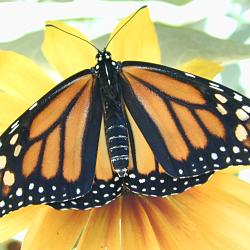 Monarch
(Danaus plexippus)
Description:
Large, conspicuous orange butterfly.
Wing margins and veination is black giving a distinctive pattern.
Upperwing is deep orange, undering is paler orange.
Sexes can be distinguished by close examination of the hindwings.
Males have two black spots
on the hind wings which are used in mating. Males also tend to have less vein pigmentation than females
and so look lighter.
Habitat:
Fields, meadows.
Wingspan: 120 mm
Adults: June - October
|
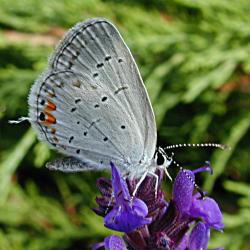 Eastern Tailed-Blue
(Everes comyntas)
Description:
Small, active butterfly found in wide range of habitats, especially dry meadows.
Upper wings bright blue, underwing grey.
When perched, wings are generally closed.
Up close, the "tail" sticks out from the hindwing.
The caterpillar host plants include clovers and vetch.
Habitat:
Fields, meadows.
Wingspan: 30 mm
Adults: June - October
|
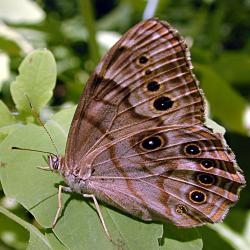 Pearly Eye
(Enodia anthedon)
Description:
Adults hang around near clearings in the forest.
The host plant for larvae is
woodland grasses.
Habitat:
Woodland
Wingspan: 50 mm
Adults: June - October
|
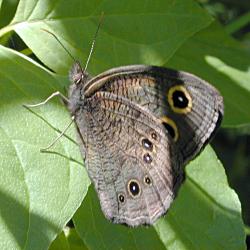 Large Wood Nymph
(Cercyonis pegala)
Description:
Attracted to rotting fruit. Adults also drink tree sap.
Habitat:
Woodland, savannah, meadows.
Wingspan: 65 mm
Adults: June - October
|
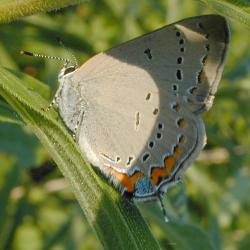 Acadian Hairstreak
(Satyrium acadica)
Description:
Orange spot on the hindwing is diagnostic.
One of the preferred food plants for adults is white clover.
Habitat:
Meadows
Wingspan: 30 mm
Adults: June - October
|
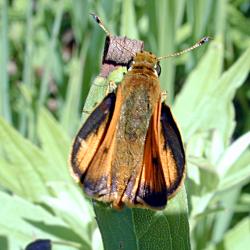 Least Skipper
(Ancloxopha numitor)
Description:
Characteristic feeble flight usually in long grass.
Habitat:
Fields, meadows.
Wingspan: 20 mm
Adults: June - October
|
|
|
